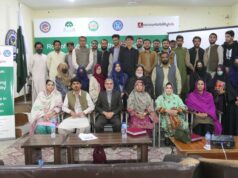 Javed Siddique
Javed Siddique
A trustworthy census is essential for a country to effectively plan growth, deliver services and solve the country’s problems. Populace census may be defined as a regular counting of the number of men, women, children, able and people with disabilities in a country by the government for the function of the better economic planning and development. Every wise parent knows that the timely and regular measurement of their newborn’s height and weight is crucial for the child’s mental and physical development. A national Census is no different.
In Pakistan’s context of censuses history, the first one in the area now comprising Pakistan was held in 1881. According to the Article 51-3 of the Constitution of Pakistan, the census should be conducted in every 10 years. After Independence, the first census was held in 1951; the second in 1961 while the third in 1972 instead of 1971 due to the political environment and war with India. The fourth census was conducted in March 1981 and the fifth one which was due in 1991 could be held in March 1998 due to specific circumstances. The political parties were mainly responsible for this undue delay.
Regular measurement of newborn’s height and weight is crucial for the child’s mental and physical development. A national Census is no different
According to 1951 census, Dominion of Pakistan (both East and West Pakistan) had a population of 75 million, in which West Pakistan had a population of 33.7 million and East Pakistan had a population of 42 million.
At the time of 1961 census, Dominion of Pakistan had a population of 93 million, in which West Pakistan had a population of 42.8 million and East Pakistan had a population of 50 million. The literacy rate of Dominion of Pakistan was 19.2% in 1961, in which East Pakistan had 21.5% literacy rate and West Pakistan had 16.3% literacy rate. As per 1961 census, the growth rate of population was 2.4%.
The third census was held in 1972, when the inhabitants of Pakistan were 65.3 million. After 1972 Census, Census Organization was made an attached department of Ministry of Interior. In 1972, Pakistan’s population was 7 million less than that of Bangladesh’s population of 72 million at that time.
According to the fourth census of Pakistan, 1981, the population was 83.782 million which is expected to shoot up to 110 million by the end of 1991.
As per 1998 census, the population of Pakistan was 130,857,717. With the addition of the population of Azad Jammu Kashmir and Gilgit-Baltistan, the population was 134,714,017 in 1998.
Pakistan’s next national census was scheduled to take place in 2008, and later in 2010 but the plan could not materialize on time. It was again expected to be held on March 2016 but due to some reasons it postponed till 2017. The reasons were likewise:
The source said that the Pakistan Bureau of Statistics (PBS), responsible for holding the census, informed the CCI, 25th March 2016 meeting, on that the required number of army personnel and teachers was not available.
There is a total of 166,801 blocks all over the country needing 375,000 soldiers to carry out the population counting exercise. But the meeting was informed that this number of army personnel cannot be spared by the army at the moment as troops are currently deployed for the ongoing Operation Zarb-e-Azb.
The second reason for delaying the census was that the process of registration of Afghan refugees had not been completed as yet. There are estimated to be over 2.5 million Afghan refugees living in Pakistan whose registration cards have expired or who remain unregistered. According to sources, the registration of Afghan refugees has been a major point of contention for provinces, especially Balochistan, which has refused to allow the holding of census before counting Afghan nationals is completed.
The third factor put forth during the meeting was the unavailability of government teachers, who would be required to carry out duties during the census. The Sources said that the CCI 25th March, 2016 meeting, led by the prime minister, decided to postpone the census bases on above mentioned reasons.
In legal side, the Census is a Federal subject as listed at Sl. NO. 38 of Federal Legislation list, Part-1, Fourth Schedule, Constitution of Pakistan. The seats in the National Assembly are allocated to each Province/FATA and Federal Territory on the basis of the population in accordance with the last preceding census officially published under Article-51(3) of the Constitution. Further, distribution of funds between the Federation and the Provinces are made through National Finance Commission. Article-160(2) speaks about the formation of the National Finance Commission which also uses census figures.
The quota for recruitment to Federal posts is also worked out on the basis of population ratios as given by the census. Establishment Division’s O.M. No. 8/9/72, TRV, dated 31st August 1973, refers in this regard. First 5 censuses were undertaken with the legal cover of Census Ordinance, 1959 amended from time to time. The 6th expected Population and Housing Census will be conducted under the legal cover of General Statistics (Re-organization) Act, 2011.
In addition, for sound socio-economic planning, data emancipation must be a central subject for the next Census in Pakistan. It is the primary responsibility of the government to report on the state of the nation. Without Census data, the government cannot advise the citizens on the state of the economy and society.










